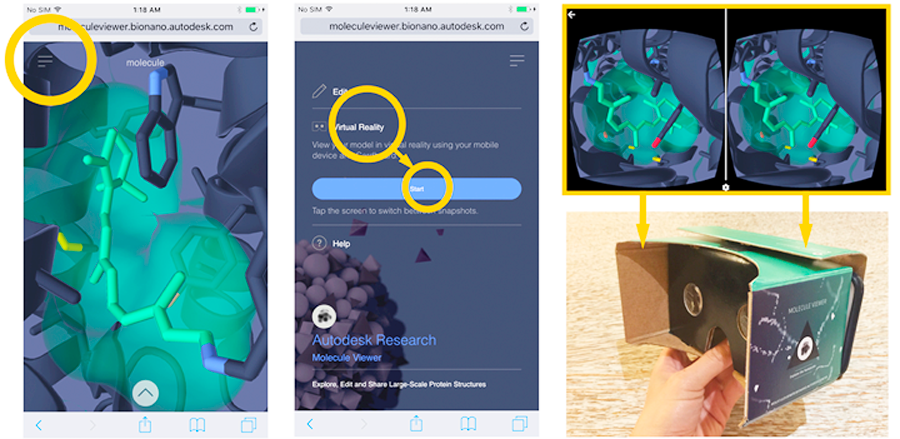
Merry Wang is a Senior Research Scientist in the BioNano group at Autodesk Research. She leads the BioNano effort on accessible tools for 3D visualization, exploration, and communication of molecular structures.
Merry has background in 3D biomedical visualization from the Institute of Medical Science at the University of Toronto, specializing in visualization of induced pluripotent stem cells and therapeutic cellular reprogramming.
Her interests lie in applying emerging technological trends into the realm of biology and life sciences.
Autodesk Molecule Viewer is a free, online 3D visualization tool for modern scientists and learners to explore, share, and present molecular data (molviewer.com).
Users can prepare 3D walk-throughs using customized and annotated interactive content to be shared through a web link for education, collaboration, and outreach. The VR lecture, for example, offers 5 different “snapshot” views of the molecule. Users can zoom in and rotate any of these snapshot views. In another example, text captions and annotations highlight different features of the HIV intasome.
All content created in the Viewer is supported by virtual reality viewing with headsets (Oculus Rift, HTV Vive) and smartphone Cardboard devices.
Find out more about Molecule Viewer at bionano.autodesk.com/
MoleculeViewer
Imagine walking into a conference room in the middle of a talk, and everyone in the audience is looking in different directions; some are looking up towards the ceiling, down towards their feet, turned towards the back of the room, heck—a few are even stood up facing the wall.
It was complete chaos, but it was the best thing we could have observed in doing the first-ever structural biology talk conducted in mobile virtual reality.
Last fall, I attended the EMBO ICRP conference at University of Potsdam as part of an invited talk session with Ernst Lab at University of Toronto on using the Autodesk Molecule Viewer to curate and present Exploring the Retinal Protein World in Virtual Reality (presenting are Ph.D. candidate Aidin Balo and Professor Oliver Ernst).
The experience of the talk was just as cool as you might imagine:
In a conference room of 150 retinal protein-related researchers, each conference attendee is immersed in the same molecular world on their own using just their smartphone and a Cardboard VR device. The presentation content was curated by PhD student, Aidin Balo, on how components of a protein structure change when light reaches a photoreceptor in the retina of the eye. As Aidin talks about these structural changes, he guides the audience sequentially through a set of immersive slides in virtual reality, each focusing on a molecular point of interest.
The content of the talk was authored and presented fully inside the browser-based Autodesk Molecule Viewer through a short URL (http://autode.sk/molecule). The audience went to the same URL on their smartphones browsers and followed along in virtual reality with their smartphones in their own Cardboard VR devices. For folks who didn’t have access to a smartphone, the lecture content conducted in a 3D environment was a treat.

Although interesting in observation, conducting a VR talk was not for entertainment value. 3D molecular structures are extremely organic, dense, and complex. The power of immersion in virtual reality provides novel perspectives in exploring this data and unique insights on spatial relativity between key landmarks. Molecule Viewer brings these immersive experiences to the hands of users for just a few dollars using just their smartphones and Cardboard devices.
The progression of molecular visualization from 2D to 3D in the 90’s was revolutionary and expedited research, education, and outreach in a wide range of disciplines. Just like how virtual reality has recently revolutionized the gaming and entertainment industries, our question is: To what extent can it do the same for structural biology in the way people observe, explore, and interact with molecular data? By providing direct workflows to both create and immerse in these experiences within seconds in Molecule Viewer, our BioNano group wants to find out.

Any 3D content created in Molecule Viewer is viewable in both smartphone VR using a Cardboard device, and headset devices, such as Oculus Rift and HTV Vive. To get started in VR, visit autode.sk/mvvr for a step-by-step guide.